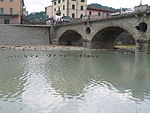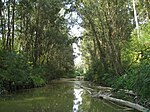Basilica of Sant'Apollinare in Classe
549 establishments6th-century churchesBasilica churches in RavennaByzantine artEarly Christian art ... and 3 more
Palaeo-Christian architecture in RavennaRavennaUse mdy dates from October 2019

The Basilica of Sant' Apollinare in Classe ("Saint Apollinaris in Classe") is a church in Classe, Ravenna, Italy, consecrated on 9 May 549 by the bishop Maximian and dedicated to Saint Apollinaris, the first bishop of Ravenna and Classe. An important monument of Byzantine art, in 1996 it was inscribed with seven other nearby monuments in the UNESCO World Heritage List, which described it as "an outstanding example of the early Christian basilica in its purity and simplicity of its design and use of space and in the sumptuous nature of its decoration".
Excerpt from the Wikipedia article Basilica of Sant'Apollinare in Classe (License: CC BY-SA 3.0, Authors, Images).Basilica of Sant'Apollinare in Classe
Via Romea Sud, Ravenna
Geographical coordinates (GPS) Address Phone number Website External links Nearby Places Show on map
Geographical coordinates (GPS)
| Latitude | Longitude |
|---|---|
| N 44.3802738 ° | E 12.2330015 ° |
Address
Basilica di Sant'Apollinare in Classe
Via Romea Sud 224
48125 Ravenna
Emilia-Romagna, Italy
Open on Google Maps










